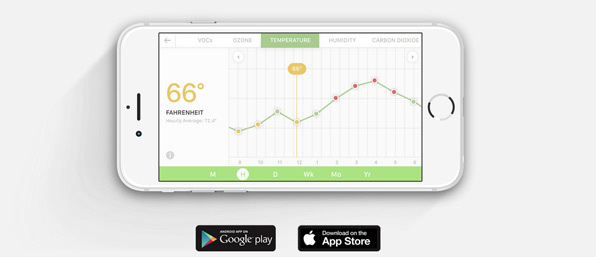The Most Advanced Indoor Air Toxin Sensor with 9 dedicated sensors. Learn how your habits affect the air you breath!
Protect yourself and your family.
| Article number: | FA-uHoo1 |
| SKU: | FUhOO-01 |
We don’t think about what we’re breathing in, and how that air affect our bodies. Until it is to late! There is strong evidence that characteristics of buildings and indoor climate significantly influence rates of respiratory disease, allergy and asthma symptoms, sick building syndrome, and worker performance. Studies have found that good indoor air quality, appropriate ventilation with clean fresh air reduces infections and chronic lung diseases. In contrast, poor indoor air quality.

CARBON DIOXIDE accumulation inside the home is normally related directly to the number of occupants. Increasing carbon dioxide levels cause decreasing oxygen levels in the body, hampering the flow of oxygen to the brain. It makes you sleepy, lazy and low in energy.

CARBON MONIXIDE is an odorless, colorless and toxic gas. Since CO is impossible to see, taste or smell, it can kill you before you are aware it is in your home. CO causes harmful health effects by reducing oxygen delivery to the body’s organs (like the heart and brain) and tissues. At extremely high levels, CO can cause death.

PARTICULATE MATTER 2.5 are fine dust particles or droplets in the air that are 2.5 microns or less in width. These are small enough that the body cannot filter them when inhaled and thus enter our lungs and absorbed into the blood and cause adverse health effects. Short-term health effects such as eye, nose, throat and lung irritation, coughing, sneezing, runny nose and shortness of breath. Long term exposure is associated with increased rates of chronic bronchitis, reduced lung function and increased mortality from lung cancer and heart disease.

VOLATILE ORGANIC COMPOUNDS are emitted as gases from certain solids or liquids. While most people can smell high levels of some VOCs, other VOCs have no odor. VOCs can cause eye, nose, and throat irritation as well as headaches, loss coordination, and nausea. They may also cause damage to the liver, kidney, and central nervous system. Some are suspected or known to cause cancer and asthma.

OZONE O3 is not emitted directly into the air, but is created by chemical reactions between oxides of nitrogen (NOx) and volatile organic compounds (VOC) in the presence of sunlight. Breathing ozone can trigger a variety of health problems, particularly for children, the elderly, and people of all ages who have lung diseases such as asthma. Inhaling fairly low amounts of ozone can still result in signs and symptoms such as coughing, congestion, wheezing, shortness of breath, and chest pain in otherwise healthy people. People with already existing asthma, bronchitis, heart disease, and emphysema may find their conditions worsen while inhaling ozone.
The uHoo app in your smartphone allows you to access all your measurments
and historical data. You can view how your habits and activities affect your home and health.

Studies have found that good indoor air quality, appropriate ventilation with clean fresh air reduces infections and chronic lung diseases. In contrast, poor indoor air quality can cause or contribute to the development of infections, respiratory diseases, chronic diseases, allergies,
and even stroke. Other common complications include immediate drowsiness, dizziness, headache and other phenomena.
Leightweight and Portable, uHoo can Monitor Indoor Air Quality Anywhere there is WiFi

Alerts sent to yur smart device to
indicate air pollution levels

Increase productivity with 10 -20% and
mental clarity with better air quality

Know when humidifiers are needed or
get alerts for mold growth
| Size: | 158mm x 85 mm |
| Color: | White |
| Sensors: | Carbon Dioxide CO2, Carbon Monoxide CO, Particulate Matter 2.5, Volatile Organic Compounds VOC's, Ozone O3, Nitrogen, Temperature, Air Presure, |
| Content: | uHoo, Micro USB Cable, Power Adapter |